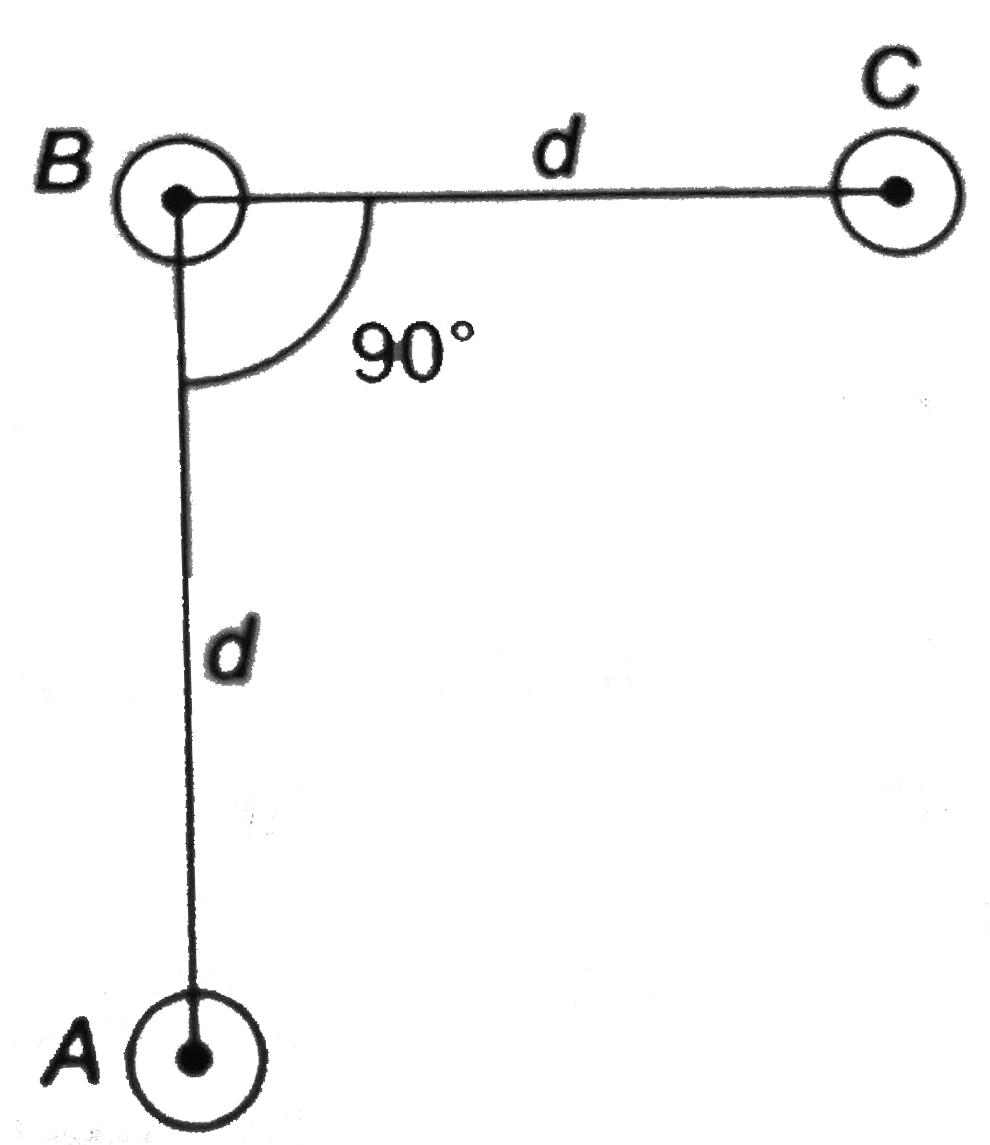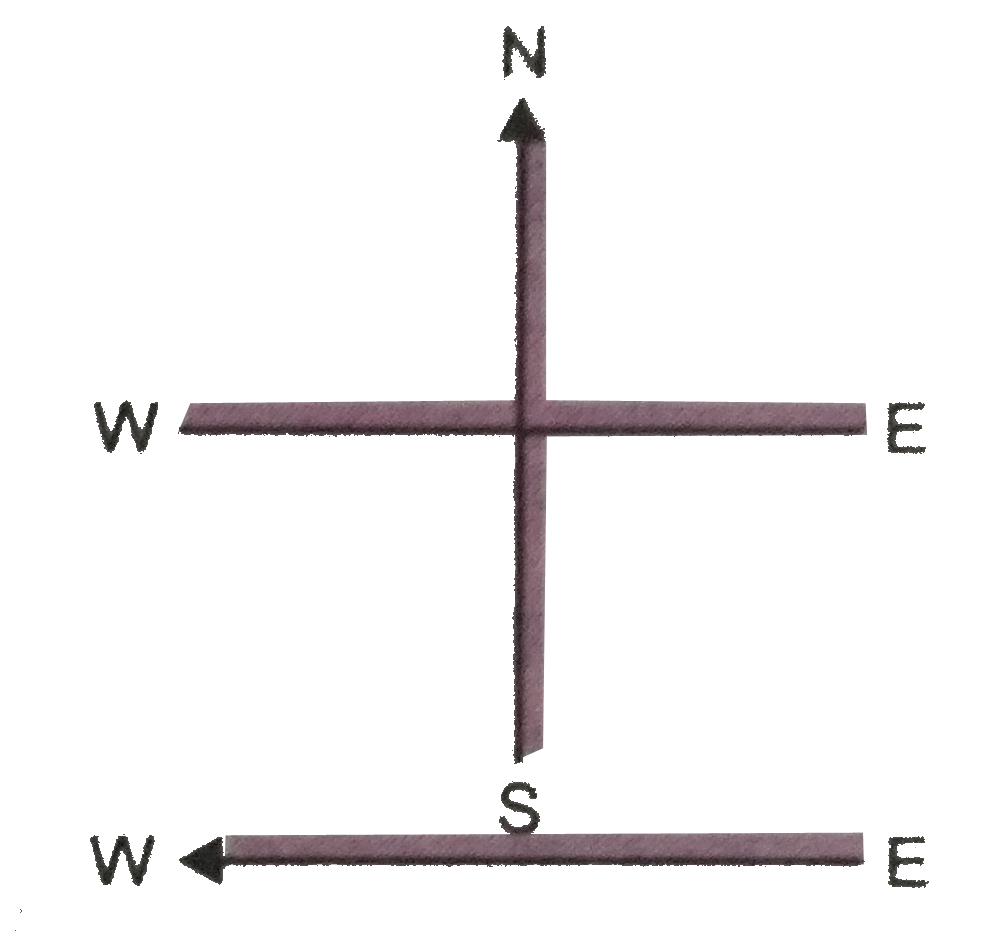Two infinitely long straight parallel wire are 5 m apart, perpendicular to the plane of paper. One of the wires, as it passes perpendicular to the plane of paper, intersects it at A and carries current I in the downward direction. The other wire intersects the plane of paper at point B and carries current k int the outward direction O in the plane of paper as shown in Fig. With x and y axis shown, magnetic induction at O in the component form can be expressed as

→B=μ0i2π[−ˆi+3ˆj5]
→B=μ0i5π[−ˆi+7ˆj24]
→B=μ0i4π[−3ˆi+7ˆj18]
→B=μ0i7π[−2ˆi+3ˆj5]
The correct Answer is:B
From trogonometry,
AP=16/5andPB=9/5.Thus
SinAOP=4/5andcosAOP=3/5
sinBOP=3/5andcosBOP=4/5
Magnetic field due to A is BA=μ0I8π which makes angle θ
with negative x-axis and lies in third quadrant.

Magnetic field at O due to wire B is (BB)=μ0i6πwhich makes angle θ with y-axis and lies in second quadrant. In components form,
−→BA=μ0i8π(−45i−35j)
−→BB=μ0i6π(−35i−45j)
Thus, −→BA+−→BB=μ0i5π(−i+724j).
Topper's Solved these Questions
- MISCELLANEOUS VOLUME 5BOOK - CENGAGE PHYSICS ENGLISHCHAPTER - MISCELLANEOUS VOLUME 5EXERCISE - Multiple Correct
34 Videos
- MISCELLANEOUS VOLUME 5BOOK - CENGAGE PHYSICS ENGLISHCHAPTER - MISCELLANEOUS VOLUME 5EXERCISE - Linked Comprehension
84 Videos
- MISCELLANEOUS VOLUME 3BOOK - CENGAGE PHYSICS ENGLISHCHAPTER - MISCELLANEOUS VOLUME 3EXERCISE - True and False
3 Videos
- NUCLEAR PHYSICSBOOK - CENGAGE PHYSICS ENGLISHCHAPTER - NUCLEAR PHYSICSEXERCISE - ddp.5.5
14 Videos
Similar Questions
Two wires are held perpendicular to the plane of paper and are 5 m apart. They carry currents of 2.5 A and 5 A in same direction. Then, the magnetic field strength (B) at a point midway between the wires will be
View SolutionTwo long straight parallel wieres are 2m apart, perpendicular to the plane of the paper. The wire A carries a current of 9.6A, directed into the plane of the paper. The wire B carries a current such that the magnetic field of induction at the point P, at a distance of 1011 m from the wire B, is zero. find
a. the magnitude and directiion of the current in B.
b. the magnitude of the magnetic field of induction of the pont S.
c. the force per unit length on the wire B.

View SolutionTwo long parallel wire A and B situated perpendicuilar to the plane of the paper at a distance 2a are carrying equal currents I in opposite direction as show in the figure . The value of magnetic induction at point P situated at equal distance r from both the wires will be

View SolutionAn arrangment of three parallel staright wires placed perpendcular to plane of paper carrying same current I along the same direction is shown in figure. Magnitude of force per unit length on the middle wire 'B' is given by

View SolutionA square loop of wire carrying current I is lying in the plane of paper as shown in Fig. 1.141. The magnetic field is present in the region as shown. The loop will tend to rotate

View SolutionTwo long, straight, parallel wires are 1.00m apart (as shown in Fig). The upper wire carries a current I1 of 6.00A into the plane of the paper.

What is the magnitude of the net field at S?
View SolutionTwo long, straight, parallel wires are 1.00m apart (as shown in Fig). The upper wire carries a current I1 of 6.00A into the plane of the paper.

What is the magnitude of the net field at Q?
View SolutionA constant current flows in a horizontal wire in the plane of the paper from east to west as shown in figure. The direction of magnetic field at a point will be North to South:

View SolutionA current I is flowing in a straight conductor of length L. The magnetic induction at a point distant L4 from its centre will be
View SolutionA wire frame of given shape, carrying current of 10 A is placed in uniform magnetic field 100 T directed into the plane of paper as shown in figure. The net force acting on frame is
View Solution
